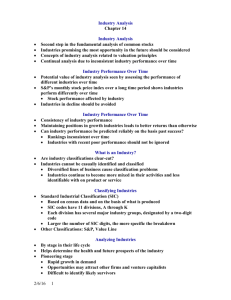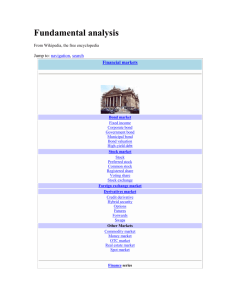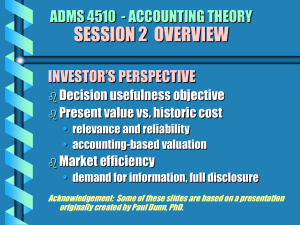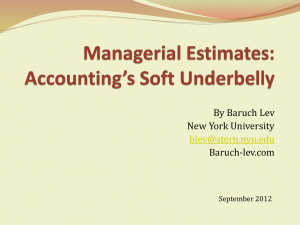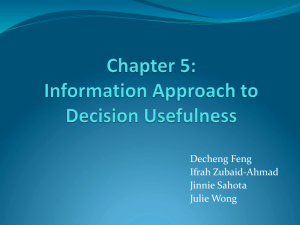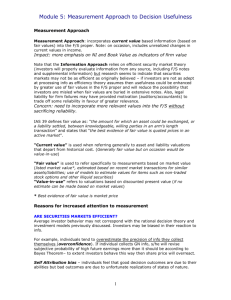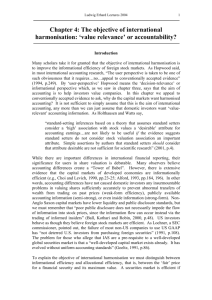Chapter 11
advertisement
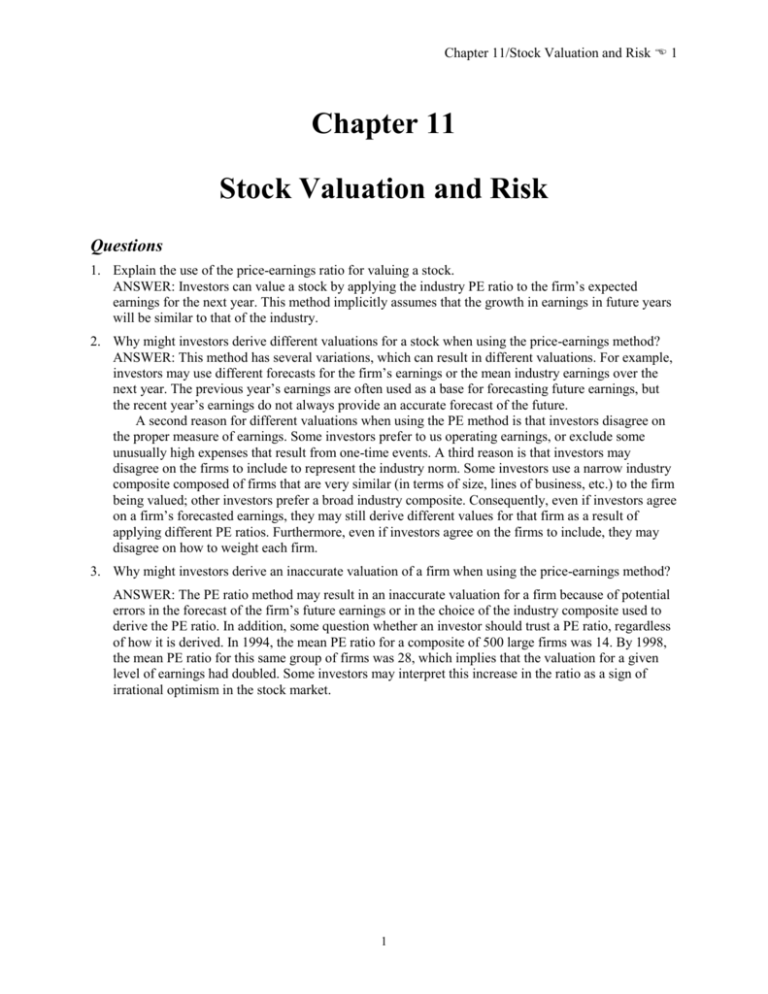
Chapter 11/Stock Valuation and Risk 1 Chapter 11 Stock Valuation and Risk Questions 1. Explain the use of the price-earnings ratio for valuing a stock. ANSWER: Investors can value a stock by applying the industry PE ratio to the firm’s expected earnings for the next year. This method implicitly assumes that the growth in earnings in future years will be similar to that of the industry. 2. Why might investors derive different valuations for a stock when using the price-earnings method? ANSWER: This method has several variations, which can result in different valuations. For example, investors may use different forecasts for the firm’s earnings or the mean industry earnings over the next year. The previous year’s earnings are often used as a base for forecasting future earnings, but the recent year’s earnings do not always provide an accurate forecast of the future. A second reason for different valuations when using the PE method is that investors disagree on the proper measure of earnings. Some investors prefer to us operating earnings, or exclude some unusually high expenses that result from one-time events. A third reason is that investors may disagree on the firms to include to represent the industry norm. Some investors use a narrow industry composite composed of firms that are very similar (in terms of size, lines of business, etc.) to the firm being valued; other investors prefer a broad industry composite. Consequently, even if investors agree on a firm’s forecasted earnings, they may still derive different values for that firm as a result of applying different PE ratios. Furthermore, even if investors agree on the firms to include, they may disagree on how to weight each firm. 3. Why might investors derive an inaccurate valuation of a firm when using the price-earnings method? ANSWER: The PE ratio method may result in an inaccurate valuation for a firm because of potential errors in the forecast of the firm’s future earnings or in the choice of the industry composite used to derive the PE ratio. In addition, some question whether an investor should trust a PE ratio, regardless of how it is derived. In 1994, the mean PE ratio for a composite of 500 large firms was 14. By 1998, the mean PE ratio for this same group of firms was 28, which implies that the valuation for a given level of earnings had doubled. Some investors may interpret this increase in the ratio as a sign of irrational optimism in the stock market. 1 2 Chapter 11/Stock Valuation and Risk 16. Explain how to estimate the beta of a stock. ANSWER: The beta of a stock can be estimated by obtaining returns of the firm and the stock market over the last 12 quarters and applying regression analysis to derive the slope coefficient as in this model: Rjt = B0 + B1Rmt + ut where Rjt = return of stock j in time t Rmt = market return B0 = intercept B1 = regression coefficient that serves as an estimate of beta ut = error term Some investors or analysts prefer to use monthly returns rather than quarterly returns to estimate the beta. The choice is dependent on the holding period for which one wants to assess sensitivity. If the goal is to assess sensitivity to monthly returns, then monthly data would be more appropriate. The regression analysis estimates the intercept (B0) and the slope coefficient (B1), which serves as the estimate of beta. 17. Describe the value-at-risk method for measuring risk. ANSWER: Value at risk is a risk measurement that estimates the largest expected loss to a particular investment position for a specified confidence level. It is intended to warn investors about the potential maximum loss that could occur. If the investors are uncomfortable with the potential loss that could occur in a day or a week, they can revise their investment portfolio to make it less risky. The value at risk is also commonly used to measure the risk of a portfolio. Some stocks may be perceived to have high risk when assessed individually, but low risk when assessed as part of a portfolio. This is because the likelihood of a large loss in the portfolio is influenced by the probabilities of simultaneous losses in all of the component stocks for the period of concern. Problems 2. Assume Mess stock has a beta of 1.2. If the risk-free rate is 7 percent, and the market return is 10 percent, what is the expected return on Mess stock? ANSWER: Expected return = 7% + 1.2(10% – 7%) = 10.6% 3. Using multexinvestor.com, you found that IBM is expected to generate earnings of $4.38 per share this year, and that the mean P/E ratio for its industry is $27.195. Using the P/E valuation method, what should be the value of IBM shares? ANSWER: Value = (Expected earnings of IBM per share) x (Mean industry P/E ratio) Value = $4.38 27.195 Value = $119.114 2 Chapter 11/Stock Valuation and Risk 3 4. Suppose that you are interested in buying the stock of a company that has a policy of paying a $6 per share dividend every year. Assuming no changes in the firm’s policies, what is the value of a share of stock if the required rate of return is 11 percent? ANSWER: PVof stock = D/k = 6/0.11 = $54.5 per share. 5. Micro, Inc. will pay a dividend of $2.30 per share next year. If the company plans to increase its dividend by 9 percent per year indefinitely, and you require a 12 percent return on your investment, what should you pay for the company’s stock? ANSWER: PVof stock = D1/k-g PVof stock = 2.3/0.12 – 0.09 = $76.67 per share 8. A share of common stock currently sells for $110. Current dividends are $8 per share, and are expected to grow at 6 percent per year indefinitely. What is the rate of return required by investors in the stock? ANSWER: D1 = D0 (1 +g) D1 = $8.00 (1 + 0.06) = $8.48 k = (D1/PV of stock ) + g k = (8.48/110) + 0.06 = 0.137 = 13.7% 9. A stock has a beta of 2.2, the risk-free rate is 6 percent, and the expected return on the market is 12 percent. Using the CAPM, what would you expect the required rate of return on this stock to be? What is the market risk premium? ANSWER: Rj = Rf + Bj (Rm – Rf ) Rj = 6% + 2.2 (12% – 6%) Rj = 19.2% The market risk premium is 6 percent. 11. Suppose you bought a stock at the beginning of the year for $76.50. During the year, the stock paid a dividend of $0.70 per share and had an ending share price of $99.25. What is the total percentage return from investing in that stock over the year? ANSWER: R = (SP – INV + D)/INV R = (99.25 – 76.5 + 0.70)/76.5 = 0.306 = 30.6% 3

